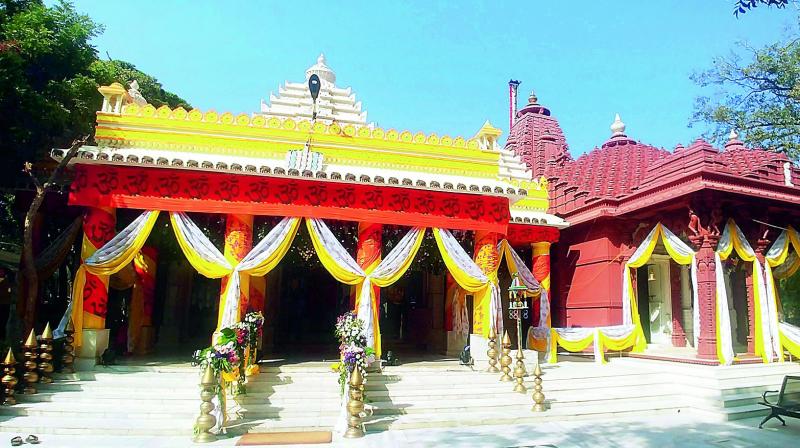The terracotta temple

Hyderabad: Shri Jain Shwetambar Jin Kushal Suriji Dadaji Bagh Mandir, the oldest Jain temple here, will celebrate its 200th year of existence on October 15 this year. It is located in Karwan, near Gudimalkapur.
Gudimalkapur is where the vegetable wholesale market for Hyderabad region is located. Crowded constantly, it also rubs shoulders with notorious Karwan locality. Densely populated, this area used to house ‘saukars’ or money lenders who belonged to the Jain community and were from Rajasthan mostly.
In fact Karwan was earlier known as Sahu Karwan. And therefore not surprisingly, there are close to 20 Jain temples in and around this area but the Shri Jain Shwetambar Jin Kushal Suriji Dadaji Bagh Mandir is the oldest among them all.
The trust chief of the temple is Surendra Luniya, a philanthropist, who is associated with 100 other organisations.
It is a tad difficult to find this temple, popularly known as the Dadabadi Jain temple.
It is just off the main road and ensconced in one corner of six acres and more of property which also houses a wedding function hall and other offices.
Once you enter this place, a certain calm rests on you. Clean spaces, blue coloured doors, white marble edifice and abutting a terracotta temple, you experience all this at one go. Then there are chairs facing the temple and as you take a seat, the falling leaves rustle as they drop with the breeze and then you see the old step well, which brings good omen, and a new colourful play ground for children. It all suits well with the peaceful ambience.
This Dadabadi Jain temple is dedicated to the third guru, Acharya Shri Jin Kushal Suri and his Charan Padukas hold a special place in the humongous hall that is devoted to this.
Dadabadi is a type of shrine, usually located near a Jain temple, and dedicated to one of the four gurus held in esteem by the community belonging to the Shwetambar Jain sect.
Mahavir Swami as the 24th Tirthankar was known as the founder of Jainism and this is because when he became the 24th Tirthankar, Jainism was waning and he helped re-establish it. In fact each Tirthankar is termed as the founder of Jainism, not because they established Jainism but because they re-established Jainism.
But after Mahavir Swami, there were no more Tirthankaras and like in any other religion many saints and monks existed, but mainly the credit was given to the four acharyas and they were called Dada Gurudevas.
Dada Gurudev means supreme teacher and deity. The four gurus are Shri Jin Datta Suri, Shri Manidhari Chandra Suri, Shri Jin Kushal Suri and Shri Jin Chandra Suri.
Monks advised the trust members of the Dadabadi Jain temple that a temple must be built beside the guru’s hall and so a temple was built in 2007 with Lord Shantinath, the 16th Tirthankar as the main deity. This main idol though made of marble is greatly highlighted by colourful marble tiles. There are four other Tirthankaras, two beside the main idol and two placed in the niches at the entrance. The top of this sanctum has a circular dome or a Gumbaz. In fact the entire temple has been made without the use of iron and it looks grand and gorgeous in its terracotta charm.
Like many other temples, this temple was built with the help of Sompura Brahmins who are settled in Rajasthan and Gujarat and practice temple architecture along with shilpshastra.
Pajoshan or Paryushan is the most important annual holy event for the Jains and lasts for four months and is popularly known as Chatur Maas when a lot of piety is maintained and people gather in various Jain temples and listen to preachings. Poojas are also conducted almost every Sunday.
During the monsoons, the monks do not travel because of the rains and so these four months have been devoted to piety.
Praveen Jain, a businessman and a trust member has been coming to Dadabadi since a very long time. And he comes from distant Himayathnagar. But every morning, he and his wife come to worship the Lord, dressed in pious clothes.
“There is no question of distance. This place gives me great peace of mind,” he said with a smile.
A lamp burns here continuously, known as the ‘Akhand Jyoti’. There is a hereditary priest also at the temple who conducts the poojas in the morning and the evening.
Amongst all this piety, this trust also does social work. They run an ashram for the old and it is run by the Shri Jain Sevasharam Mahila Vibhag, a women’s group. This old age home is called Jain Sevashram and was started in 1995.
Meena Mutha is very proud of her home and runs it with confidence thanks to the help she gets from the Jain community. “The community is very helpful and donates generously for every celebration in this family,” she says.
The quietness around here is only broken by a bird’s song, through the day, thanks to the greenery around.

